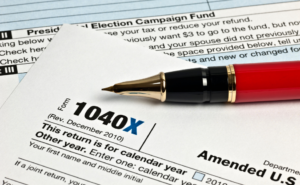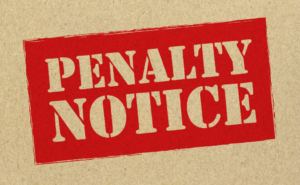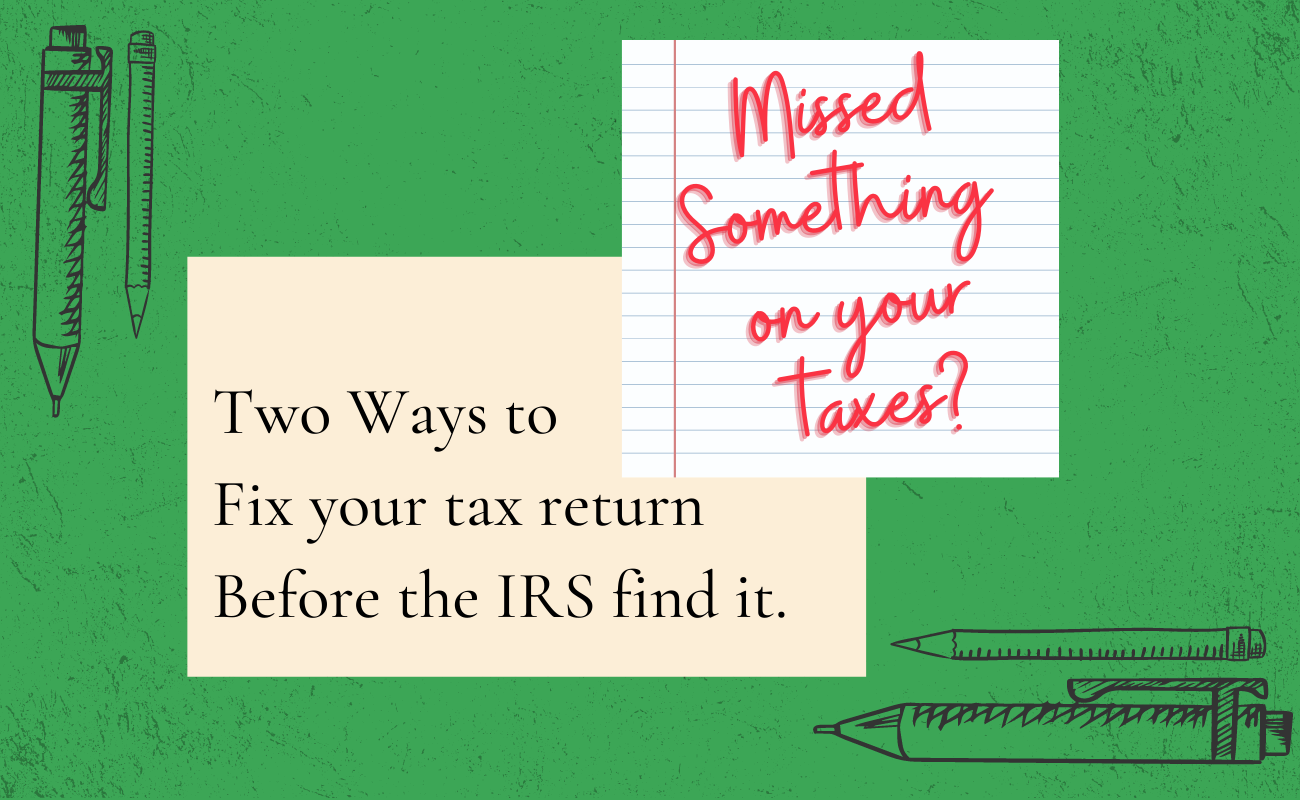Made a mistake on your taxes? Here is how to fix it before the IRS discovers them
 The tax law is complicated and constantly changing.
The tax law is complicated and constantly changing.
That is no surprise! It is easy to make a small or large error that causes you to:
- Underpay your tax, leaving you open to IRS penalties,
- Overpay your tax, meaning you gave a gift to the government.
Here’s the good news: you can undo your mistake.
There are two special ways to fix your incorrect tax return. These may save you from paying more to the IRS.
Two saving graces:
If you made an error in the one you originally filed
- A superseding return
- A qualified amended return.
Superseding Return 
A superseding return, the IRS treats the new information as if you included it on your originally filed tax return.
This is an amended return (Form 1040X) or a corrected return (duplicate Form 1040) filed on or before the original or extended due date. You can also file superseding returns for business entity returns, such as Form 1065 for partnerships and Form 1120 or Form 1120S for corporations.
The courts have consistently held that most tax return elections required to be made on a timely tax return can be made or changed on a superseding return.
Irrevocable election is different. In the case of an irrevocable election—which is an election that, once made, can never be undone—the IRS takes the position that you must file the superseding return before the original due date of the tax return. Two examples of common irrevocable elections you might want to later change include
- The married-filing-jointly election,
- The Section 179 deduction election.
If you are concerned about an IRS audit, don’t worry—the filing of a superseding return does not give the IRS additional time to audit and assess additional tax.
The IRS uses the tax you show on the superseding return when determining most penalties, including the tax underpayment penalty and the accuracy-related penalty in an audit.
How to File a Superseding Return
If you file a corrected duplicate return on Form 1040 or another form, you’ll need to snail mail the return to the IRS. You should put “SUPERSEDING RETURN – IRM 21.6.7.4.10” in red at the top of page 1 of Form 1040.
If you file an amended return on Form 1040X or another form, you may be able to electronically file it. If you can’t electronically file it, then follow the instructions above for mailing the Form 1040X to the IRS.
It doesn’t matter whether you file a corrected duplicate return or an amended return. They are both superseding returns as long as they are filed before the due date.
Superseding Return Example
You file a joint Form 1040 tax return electronically on February 21, 2022, for tax year 2021, but you later decide you want to file a separate return.
Since the joint-filing election is irrevocable, on or before April 15, 2022, which is the unextended due date for your 2021 Form 1040, you must file a superseding return to undo the joint election.
IRS electronic filing rules for amended returns do not permit you to file this superseding return electronically, because you are changing your filing status (from married, filing jointly, to married, filing separately).
By snail mail, you’ll submit either
- a second original Form 1040 return using the married-filing-separately filing status,
- an amended Form 1040X showing the change from joint to separate filing status.
Be sure to write “SUPERSEDING RETURN – IRM 21.6.7.4.10” in red at the top of page 1 of either Form 1040 or Form 1040X.
Qualified Amended Return
If you file an amended return to correct a return error and you owe more tax on the amended return, the IRS won’t charge you the 20 percent accuracy-related penalty if you file a “qualified” amended return.
You’ll still pay interest on the additional tax back to the due date of the return. However, the penalty is zero if you timely pay your IRS bill.
A qualified amended return is an amended return that you file after the due date of the return (including extensions) and before the earliest of the date the IRS contacts you for the following:
- Concerning any examination (including a criminal investigation) with respect to the return
- An examination for claiming an abusive tax shelter benefit
- A pass-through entity in connection with an examination of an item on your tax return
- Serves a John Doe summons related to the tax liability of a person, group, or class of which you are a part
- Announces formal guidance published in a settlement with respect to a listed transaction in which you participated.
In most circumstances, a qualified amended return will be one you file prior to the date that the IRS contacts you regarding an examination of the return for that tax year.
How to File a Qualified Amended Return
You simply file a Form 1040X or other form either electronically (if permitted by IRS rules) or by mail.
You do not have to specifically notate the amended return as a qualified amended return, but be sure to keep proof of the date the IRS receives the return in case you need to later show you filed a qualified amended return.
Qualified Amended Return Example
You realize you left a $30,000 IRA distribution off your 2019 tax return. (Ouch!)
Let’s assume you are in the 32% tax bracket and had no federal income tax withholding on the distribution:
- You owe an additional $9,600 in federal income tax on your 2019 tax return due to this distribution.
- If you file an amended return before the IRS contacts you about the missing income, then it’s a qualified amended return, and you avoid the 20% penalties.
- The IRS contacts you about the missing income, without having filed an amended return, they will propose the $1,920 penalty. You may be able to request penalty relief, but you’ll have to make your case, and the facts may or may not be on your side.
In both circumstances, you’ll also pay interest on the $9,600 back to July 15, 2020. Of course, the earlier you pay the tax, the less interest you’ll accrue. You’ll pay less interest with a qualified amended return because you’re paying the tax sooner.





